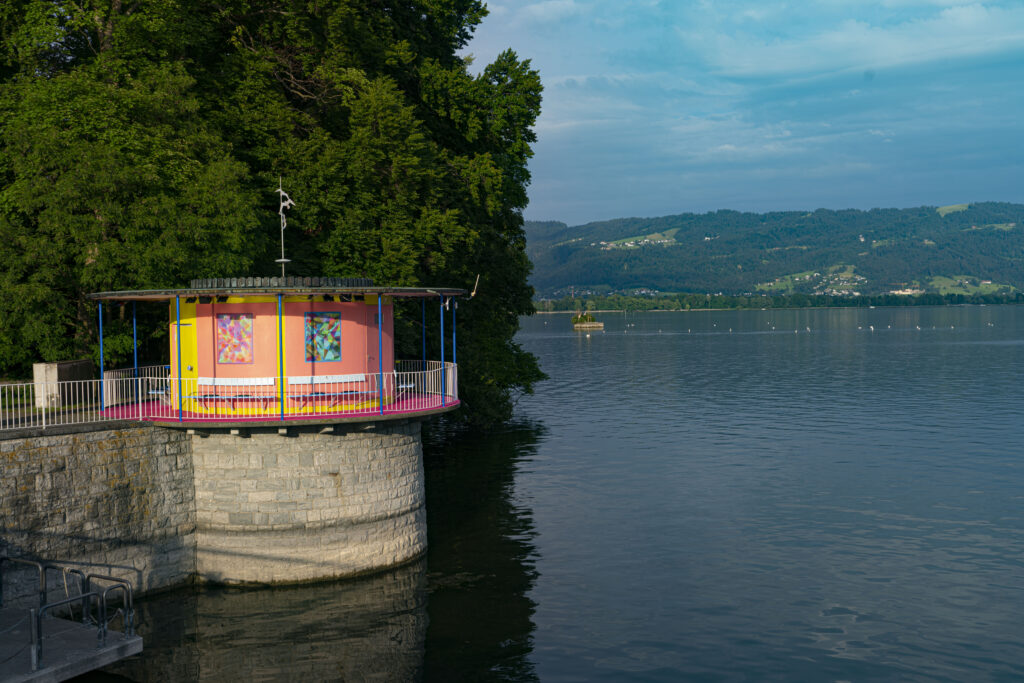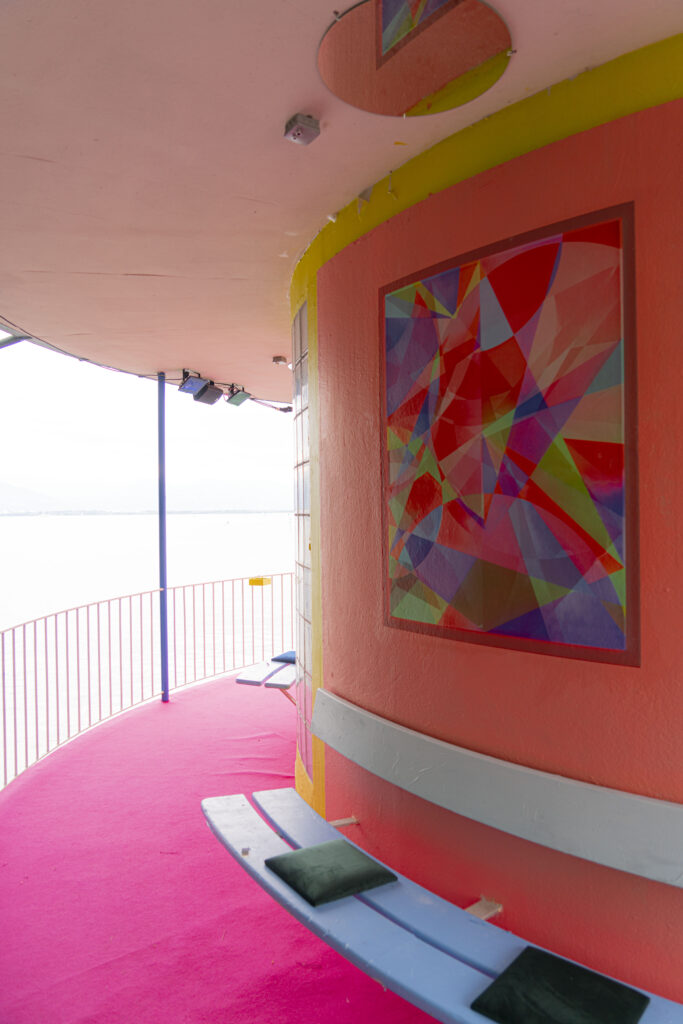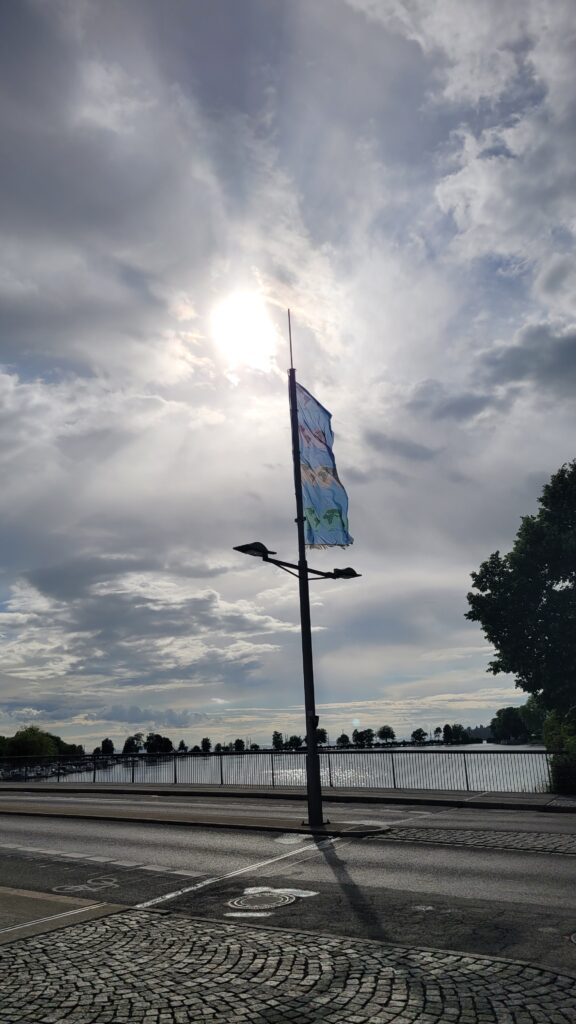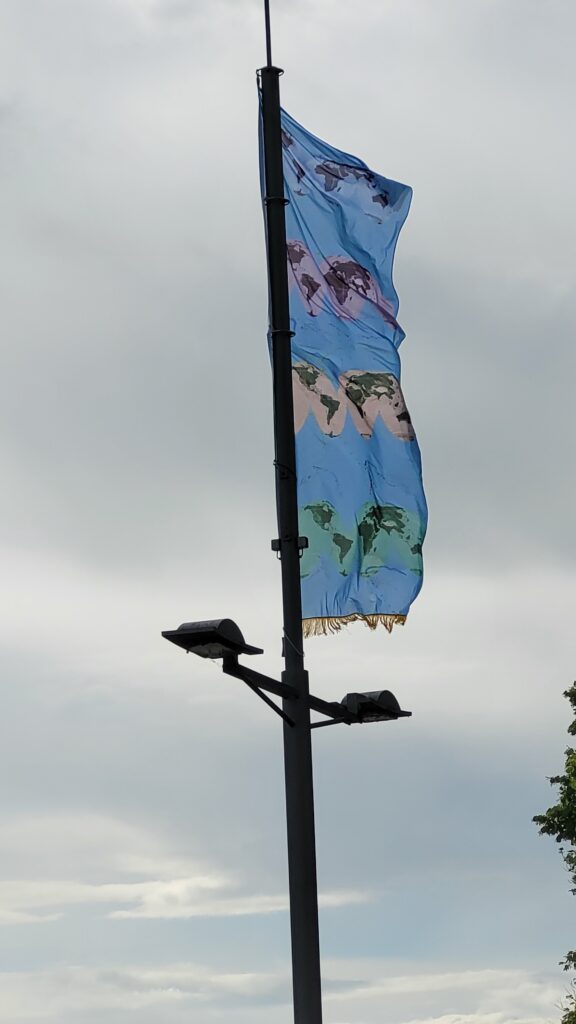In situ paradise, Biennale Lindau
PARAJENSEITS HIER!
Dana Greiner arbeitet medienübergreifend und installativ. Sie verbindet Malerei, Musik, Skulptur, Film,Licht- und Soundinstallation zu einer Einheit und erschafft intensive Bildwelten innerhalb und außerhalbgesellschaftlicher Kontexte. Ursprünglich aus der Malerei kommend, halten mittlerweile vermehrt digitaleMedien und 3D-Druck Einzug in ihr Schaffen. In diesem Facettenreichtum entstehen meist mehrere Arbeitengleichzeitig, die sie miteinander in Korrespondenz setzt, Räume absteckt und bespielt.Der Mensch, Hauptakteur und wichtigster Zuschauer zugleich, steht im Mittelpunkt ihrer Arbeit. Intermedialund allumfänglich bedient sie sich unterschiedlichster Medien und nutzt diese als Übersetzungsmöglichkeit, um Betonungen zwischen den Zeilen zu setzen.Dabei entsteht Raum für Poesie, Pop, Politisches und Ästhetisches, wobei sich diese Begriffe nie eindeutig nur auf eine Seite schlagen, sondern immer auch innerhalb einer Arbeit die diametrale Nachbarschaft zu deren Gegenteil suchen.
Das Thema „In situ paradise“, der Biennale Lindau, behandelt die Künstlerin in der vierteiligen Werkschau
PARAJENSEITS HIER! Sie beschäftigt sich mit dem Paradies als Konzept, sowie den gesellschaftlichen und
menschlichen Hindernissen diese Utopie wahr werden zu lassen. Hierfür kreiert sie eine Art Bild-Sinnesraum
– einen physisch erfahrbaren, öffentlichen Raum, den sie mit Hilfe unterschiedlicher Standorte sowie
Teilwerke bestimmt. Am Ende ihrer Arbeit bleiben Hoffnung, Selbstreflexion und Selbstermächtigung.
Die Installation „I SEE WHO YOU ARE, WHAT SHADOWS WE ARE„ (REFLEXIONSMASCHINE) ist
eine Installation am Pumphäuschen beim Toskanapark. Im malerischen Sinne jedoch auch sinnbildlich wird
die Kloakenpumpe als Bildfläche genutzt, in unterschiedlichen Materialen bearbeitet und zu einem eigenständigen
Werk gestaltet. Es soll anreizend wirken, wie eine Sirene einladen Platz zu nehmen um den Ausblick
auf den Bodensee und die Altstadt zu genießen. Sobald man sich jedoch setzt, beginnt eine Soundcollage
die Besucher:innen mit „Beschimpfungen“ zu beschallen. Eine hybride Stimme, die weder männlich noch
weiblich konotiert ist, stellt existentielle Fragen in den Raum, verunsichert, beleidigt und greift gesellschaftliche
Ressentiments auf, doch nie so, dass sich eine besondere Gruppe ausgeschlossen fühlt, sondern immer
jeder Einzelne. Ein „paradiesischer“ Ort an dem sich jedes Individuum ausgegrenzt fühlt, für das was man
ist: Mensch
„THE URGENT DESIRE TO TAKE LESS SPACE IN THE WORLD“ ist eine Arbeit die sich im Laufe der
Ausstellungsvorbereitung in zwei Teile (Pt. 1 und Pt. 2 (ISLE OF MEN, Autocratic Edition) aufgeteilt hat.
Pt.1 ist eine Arbeit bestehend aus zwei lebensgroßen Männerskulpturen, deren Geschlechtsteile unbeholfen
in Objekte im öffentlichen Raum platziert werden. Greiner spielt hier auf ironische Art mit der neuen männlichen
Rolle, in welcher sich der Mann, gleichberechtigt zur Frau, aktiv positionieren muss und deshalb sein Glied
in unterschiedliche Öffnungen im Stadtbild platzsparend einordnet und aufräumt – eben ein „aufrechtes Verlangen weniger Platz in der Welt einzunehmen“.
„THE URGENT DESIRE TO TAKE LESS SPACE IN THE WORLD. Pt.2 ( ISLE OF MEN. AUTOCRATIC
EDITION“) ist eine Arbeit, die sich im Zuge des Ukraine Krieges aus Pt.1 heraus entwickelt hat. 3D-Köpfe
von 10 Autokraten weltweit wurden von Dana Greiner „platt gemacht“ und in ihre entsprechende zweidimensionale
Form gebracht. Greiners Werkreihe der „Unfolded bodies“ bearbeiten verschiedene dreidimensionale
Körper und deren aufgeklappte Fläche. Aus den einzelnen Autokratenköpfen entstehen inselartige
Gebilde, die sich großflächig auf einer Wiese zu der „Isle of Men“ formieren. Die Köpfe der Insel, die aus
ukrainischer Birke gefertigt sind, können und sollen bestiegen werden.
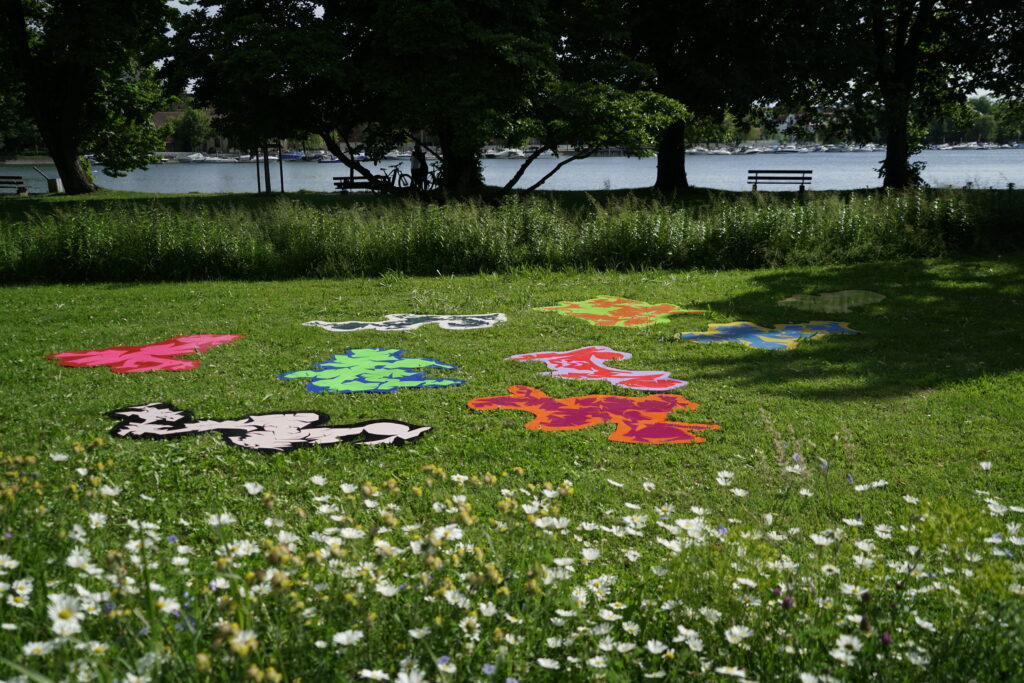

Die vierte Arbeit „NO-TION FLAG (Goode homolosine)“ besteht aus einer Flagge ohne nationalen Ursprung.
Auf ihr ist eine Weltkarte abgedruckt, wie sie John Paul Goode in den 20er Jahren des letzten Jahrhunderts
flächengetreu eingeteilt hat. Es gibt zahlreiche Möglichkeiten die Weltkugel als Karte darzustellen.
Je nachdem wie man sie aufklappt, verändern sich die Größenverhältnisse der einzelnen Länder, was Begehrlichkeiten
weckt und Wahrheiten verzerrt. Auf Greiners bedruckten, bestickten und bemalten Flagge wird
der Goode Homolosine Kartennetzentwurf, das stark an vier Brüste erinnert und ebenfalls als „unfolded
body“ gelten kann, als NO-TION FLAG neben den Nationalflaggen gehisst.
Im Kontext dieser vierteiligen Werkschau kann das Paradies als gesellschaftliche Utopie gelesen werden, die
nur existiert, wenn die Gesellschaft selbst daran glaubt, eine genaue Verortung jedoch nur schwer vorstellbar
wird. Die Insel Lindau wird zum Schauplatz der paradoxen Koexistenz von Idealvorstellung und Wirklichkeit,
von aktiver wie passiver Bestrebung und Destruktion unserer Grundwerte gleichermaßen. So soll die
Suche nach dem Paradies mit dieser Position Raum zur Selbstreflexion und Kontextualisierung der Zeit in
der wir leben geben.
english version
Dana Greiner works across media and installation. She combines painting, music, sculpture, film,
light and sound installations into a unity and creates intense visual worlds within and outside of
social contexts. Originally coming from the field of painting, digital media and 3D printing are now increasingly finding their way into her work. In this multifaceted environment, she usually creates several works
which she puts into correspondence with each other, staking out spaces and playing with them.
The human being, main actor and most important spectator at the same time, is the focus of her work. Intermedial
and all-embracing, she makes use of the most diverse media and uses them as a means of translation
to put emphasis between the lines.
In the process, space is created for poetry, pop, the political, and the aesthetic, whereby these terms never clearly
side, but always seek within a work the diametrical neighborhood to its opposite. The artist deals with the theme of „In situ paradise“, the Lindau Biennale, in the four-part work show PARAJENSEITS HERE! she deals with paradise as a concept, as well as the social and human obstacles to make this utopia come true. For this she creates a kind of pictorial sensory space physically experienceable, public space, which she determines by means of different locations as well as partial works. At the end of her work, hope, self-reflection and self-empowerment remain.
The installation „I SEE WHO YOU ARE, WHAT SHADOWS WE ARE“ (REFLEXION MACHINE) is
an installation at the pump house near the Toskanapark. In a pictorial sense, but also symbolically,
the cesspool pump is used as a pictorial surface, processed in different materials and designed as an
work of art. It is supposed to have a stimulating effect, like a siren inviting you to take a seat and enjoy the view of Lake of Constance and the old town. However, as soon as one sits down, a sound collage begins to confrontate
the visitors with „insults“. A hybrid voice, which is neither male nor female connotated, questions, unsettles, offends, and picks up on social resentments, but never in such a way that a particular group feels excluded, but always every individual. A „paradisiacal“ place in which each individual feels excluded for what one is: human being
„THE URGENT DESIRE TO TAKE LESS SPACE IN THE WORLD“ is a work that in the course of the
exhibition preparation into two parts (Pt. 1 and Pt. 2 (ISLE OF MEN, Autocratic Edition).
Pt.1 is a work consisting of two life-size male sculptures, whose genitals have been awkwardly stuck
into objects in public space. Greiner plays here in an ironic way with the new male role, in which the man
must arrange himself as equal to the woman, trying to take less space in the world and therefore places his genital
in different openings in the cityscape.
„THE URGENT DESIRE TO TAKE LESS SPACE IN THE WORLD. Pt.2 ( ISLE OF MEN. AUTOCRATIC
EDITION“) is a work that evolved out of Pt.1 in the wake of the Ukraine war. 3D heads
of 9 autocrats worldwide were „flattened“ by Dana Greiner and brought into their corresponding two-dimensional
form. Greiner’s series of works entitled „Unfolded bodies“ rework various three-dimensional
bodies and their unfolded surface. From the individual autocratic heads emerge island-like
form the „Isle of Men“ on a large scale on a meadow. The heads of the island, which are made of
Ukrainian birch, can and should be climbed and conquered.
The fourth work „NO-TION FLAG (Goode homolosine)“ consists of a flag without national origin.
On it a world map is printed, as it was divided by John Paul Goode in the 20s of the last century.
There are numerous ways to display the globe as a map. Depending on how you open it up, the proportions of the individual countries change, which arouses desires and distorts truths. On Greiner’s printed, embroidered, and painted flag the Goode Homolosine map net design, which strongly resembles four breasts and can also be considered an „unfolded body,“ is hoisted as a NO-TION FLAG alongside the national flags.
In the context of this four-part show of works, paradise can be read as a societal utopia that exists only if society itself believes in it, but an exact location becomes difficult to imagine.
The island of Lindau becomes the scene of the paradoxical coexistence of ideal and reality, of active and passive aspiration and destruction of our basic values in equal measure. Thus the search for paradise with this position should give space for self-reflection and contextualization of the time in which we live.



